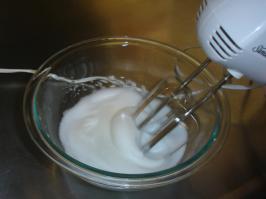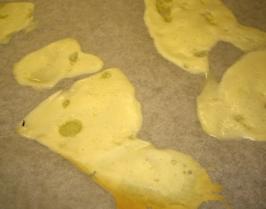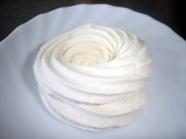Technological products in food technology
Having students experiment with ingredients proved a successful strategy for teaching technological products. Students enjoyed the activities, which not only gave them an understanding of the properties of materials but helped them remember what they learned.
Following a two-term Endeavour Teacher Fellowship in 2012, Gillian Mandley returned to the classroom keen to incorporate more experimenting into her food technology programme. In her absence, her Year 11 class had been working on a jam-making/preserving unit. Gillian wanted to follow this up with a focus on technological products to give her students an understanding of the function of materials, something they hadn't done a lot of before. Her class, however, had obviously had enough of the jam context so she decided on a two-and-a-half-week mini-unit on technological products. This unit provided an opportunity for students to be assessed against Achievement Standard 91049.
The focus of the unit was for students to explore materials. "They love the hands-on aspects, and that's how I'd prefer to teach." Gillian made a conscious decision to choose a mix of practical and theoretical activities to assist students to build an understanding, she said "understanding the performance properties – well, you just get in there and play around don't you: If you add this, what happens? Or if you add it that way, what does it do?"
Riccarton High School has a lot of international students and Gillian ensured that each one was paired with a Kiwi student for the activities, partly to ensure students mixed instead of staying with their own cultural group. It was interesting, she said, to observe how well the Kiwi students helped their second-language partners with the terminology. In response to a request from the head of international students, Gillian had given a vocabulary list to international students a week ahead of the unit. When she started the unit, however, she realised that the whole class, some of whom hadn't taken year 10 food technology, really needed the handout.

Mixing the meringue.
Given a context of meringues, the students examined ingredients then experimented with them. They started with some sensory testing, tasting and evaluating meringues – What do you think of them? What do you think the ingredients are? Is that how a meringue should be? What is your ideal meringue? Despite the multicultural nature of the class, meringues provided a good context in that everyone had previously tasted some version of them. Gillian encouraged her students to make Star Profiles as they discussed what they thought the characteristics of a meringue should be. She uses these with year 9/10 classes as a means of getting students to start thinking about the descriptors of a product. If you know what characteristics you want your product to have, it's much easier to say "well, if you use that material it makes the product like..." or "if you heat it up...".
Gillian asked her students to explain the physical and functional characteristics of sugar and eggs, and then, without giving any instructions, had each pair make meringues. "They did surprisingly well," she says, "although some students threw all of the ingredients in together and others mixed egg yokes in with the egg whites". Then students looked at all the results, tasted them and tried to work out why the meringues differed. Following this discussion, the students worked through 13 experiments – whisking up foam and storing it in the fridge or baking different combinations of meringue ingredients. These activities into a class discussion about the properties of the ingredients – If you can whip cream, why doesn't it have the structure that a meringue does? What does the egg white do? What about the sugar?

Egg white experiment.
During the unit, Gillian talked about some of the science behind what the students were working on – what albumin proteins and amino acids are, for example, or explaining what is happening when whisking a mixture with a mechanical action. The students also did their own research into the ingredients in more depth. "One of them," Gillian says, "really delved into cream – how a soft cream has lots of fat in it and why you need a certain percentage of fat. It's about the structure of materials."
Having gained an understanding of the performance properties of the meringue ingredients, the class experimented with making sponge cakes, with each group assigned one of nine recipes. The students considered the appearance, texture, and taste of each cake, then discussed why the cakes were softer than the meringues and the part each ingredient played in their baking.
This unit was such a successful method for teaching technological products that Gillian is considering putting it into the year 10 course, although she would prefer to cover the content within an holistic context rather than as a stand-alone unit. If teaching the unit again at either level, she would redo some of the meringue experiments, although this would depend on the class. There are other things that could be considered, such as adding acid. "At this stage I deliberately chose the very crisp, well dried-out type of meringue, rather than those with softer centres, so chose not to add acid. However, I do have another set of experiments to look at lower-sugar meringues, and using cream of tartar. I could do more on this and compare crisp meringues with pavlova-style meringue. It's interesting that older recipe books suggest 25g sugar per egg white, as opposed to 50g in more modern ones."
Gillian says that ideally the unit would be taught in a two-hour lesson, to allow students to taste their meringues that day, rather than storing them, because some things are still happening during storage, although that does add another dimension to the experiment. Also, a longer lesson gives students time to write about what they have discovered instead of waiting until another lesson. Given that she only has one hour, Gillian is considering smarter ways of recording evidence. One possibility is to have students take photos and write a sentence on their mobile phones, recording what their experiment told them, or what they learnt as a result. Teachers and students can access the "Tech dump" on the school's computer drive, where students from a particular class can look at shared documents and images.
Gillian is looking forward to having her year 11 students play around more with ingredients. Hopefully that will spin out and get students thinking a bit more creatively or doing new things. She also wants to make closer links with science teachers to see what they might have in common. Some of the concepts discussed, such as denaturation, are possibly already being taught in science classes. Gillian has looked at the science assessment standards and can see where Achievement Standard 90944 on acids and bases overlaps both learning areas.

